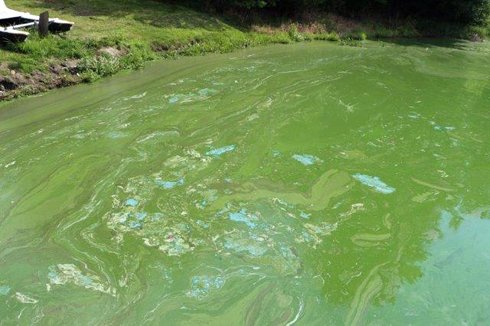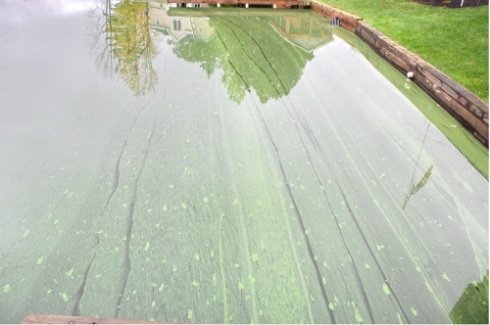HAB FAQ
Below are answers to some of the most frequently asked questions we've been receiving about HABs and some information about how AWI works to study their occurrence in the region.
What is a HAB?
Let's start with the basics. HAB stands for Harmful Algal Bloom. HABs occur when cyanobacteria capable of producing toxins grow to extremely high numbers and are concentrated at the surface of a lake. Some species of cyanobacteria are capable of producing powerful cyanotoxins. Cyanotoxins are a generalization for a variety of hepatotoxins that affect the liver, kidneys, and reproductive systems or neurotoxins which affect the nervous system. These toxins are hazardous to small children, pets, and wildlife. Dogs more frequently suffer from cyanotoxin poisoning because they can directly ingest the toxins if they lick their fur after swimming in a lake experiencing a HAB. The challenging and dangerous thing about HABs is that laboratory testing is the only way to tell if toxins are present. Even with laboratory testing, toxin presence can change over relatively short periods, so a negative result one day may not represent toxin presence just a few hours later.
Are HABs an invasive species?
No. HABs are formed by cyanobacteria, a group of widely dispersed and common native organisms. Cyanobacteria are an essential part of the plankton community in almost all lakes. Cyanobacteria are the first organisms on the planet known to produce oxygen, so you should thank them every time you take a breath. Typically, cyanobacteria are found deeper in the water column of a lake and at low to moderate abundance. Only when they move to the surface can they be problematic.
Dolichospermum sampled from a bloom in Whey Pond in the Fish Creek area.
What’s the difference between cyanobacteria and blue-green algae?
Blue-green algae and cyanobacteria refer to the same group of organisms. Blue-green algae is an outdated term that inaccurately classifies cyanobacteria as algae. Cyanobacteria are actually in an entirely different kingdom! As scientists learned more about this group of organisms, they realized they had been misclassified, and the name was updated.
What causes HABs to form?
Excess nutrients entering a lake can make HABs more likely to form, though this isn't always the case. For example, Copperas Pond in the headwaters of Saranac Lake has persistent cyanobacteria blooms over most of the summer and fall. There is no development in the watershed or source of excess nutrients, though significant rain events can flush nutrients to a lake from its watershed.
Research has also shown that under the right ratio of nitrogen and phosphorus, cyanobacteria are more likely to bloom. Some species can fix gaseous nitrogen, giving them an advantage under conditions where nitrogen is low relative to phosphorus.
In addition to nutrients, weather can play a significant role in HAB formation. Warm temperatures, sunny skies, and calm winds tend to favor cyanobacteria and increase the likelihood of HABs.
Lake mixing may also play a critical role in HAB formation in Adirondack lakes. The first HAB reported on Mirror Lake, back in November 2020, was preceded by the lake completely mixing, a process that brings nutrient-rich water to the lake's surface. The HAB formed a few days later under abnormally warm temperatures, clear sunny skies, and almost no wind. The combination of nutrients brought to the surface from mixing and weather allowed the bloom to form. Fall turnover is likely a major contributing factor for the HABs observed this year on Upper Saranac Lake, Lower Saranac Lake, and Meacham Lake. The HABs on these lakes corresponded with periods of lake mixing and weather, as was the case on Mirror Lake.
How do I identify a HAB?
HABs can take on a variety of forms. Typically, they look like clumps of green dots on the lake surface or green surface scum with parallel lines or streaks. They can also have a spilled paint-like appearance. Finally, some HABs will have the appearance of bright green water that resembles pea soup. The NYS DEC has a photo gallery to help with HAB identification.
What should I do if I see something I think might be a HAB?
The NYS DEC asks us to Know It. Avoid It. Report It. They maintain a suspicious algal bloom report form that anyone can fill out. To positively identify a bloom as a HAB, it is important to get a good close-up photo and a wider angle shot. We defer to DEC when it comes to confirming a suspicious bloom as a HAB to ensure consistency across the state.
If your lake is part of the Adirondack Lake Assessment Program, you can reach out to us, and we may be able to identify the species at our lab.
It seems like more HABs are occurring in the Adirondacks, is that true?
This is a hard question to answer because there is a good deal of what we refer to as "observer bias" in HAB reporting. With the state focusing more on educating the public about HABs and increasing its reporting efforts, more people are aware of what to look for and how to report suspected HABs. Greater awareness has resulted in more HABs being reported across the state. Observer bias makes it challenging to determine if HABs are more common or are just being reported more.
Is climate change contributing to HAB formation?
This is a great question and one we are actively working to answer. Research has linked HABs in Algonquin Park in Canada to climate change. Additionally, we know that several recent HABs in the Adirondacks are likely tied to fall turnover and the associated mixing of nutrient-rich waters from the lake bottom up to the surface. We also recently published a paper documenting a rise in September air temperature and corresponding increases in water temperature. This suggests we may see more favorable conditions for HAB formation in our lakes in a warmer future.
What is AWI doing to understand HABs in the Adirondacks?
This summer, our field staff were trained in HAB identification and began reporting suspicious algal blooms to NYS DEC. This training resulted in HABs being confirmed in Copperas Pond, Whey Pond, Rat Pond, Barnum Pond, Upper Saranac Lake, and Lower Saranac Lake. We also began identifying the dominant genera of cyanobacteria in these blooms back in our lab.
We are also using the Upper Saranac Lake Environmental Monitoring Platform to understand better the weather and lake conditions that preceded the HABs formed on Upper Saranac Lake and nearby lakes. The platform allows us to look at what is happening in the days and hours leading up to a bloom, which is critical to our understanding of bloom formation.
Our lab team is also evaluating adding additional analyses to our routine monitoring programs. These may include looking at different forms of phosphorus and nitrogen that are more available to cyanobacteria and other phytoplankton and beginning testing for cyanotoxins.
Finally, we are seeking funding to expand the study of Copperas Pond, Whey Pond, and Rat Pond, all of which are in the headwaters of Upper Saranac Lake. Understanding the conditions leading to blooms in these small, primarily undisturbed headwater ponds will help us better understand bloom formation on other lakes in the region.
AWI staff working on the Upper Saranac Lake Environmental Monitoring Platform.






